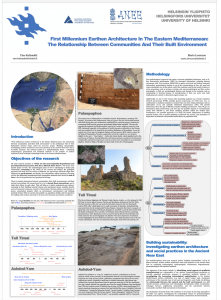Benjamín Cutillas-Victoria has joined the #BuildingSustainability team! Benjamín was awarded his PhD (2020) at the University of Murcia (Spain) where he investigated the ceramic assemblages of the autochthonous communities and Phoenicians in the Iberian Southeast. In this respect, the application of archaeometric techniques has been essential to discuss how ceramics showcase important social phenomena such as the configuration of identities, agency, cultural resistance or hybridisation, a perspective of research to continue developing within the project #BuildingSustainability. His training in archaeometry has been possible thanks to several formation stages at the Universities of Barcelona, Sheffield and Lisbon.
Elemental analysis with portable XRF / Alkuaineanalyysi kannettavalla XRF-spektrometrillä
Elemental analysis with portable XRF
by Uine Kailamäki
One of the analysis methods we use in our project to categorize and examine the mudbrick samples beyond just their visible features is elemental analysis with pXRF (portable X-ray fluorescence spectrometer). This non-destructive and relatively fast-to-conduct analysis is done with a futuristic looking “X-ray gun” (in the picture) that bombards the sample with X-rays. These X-rays then knock off electrons in the sample atoms, which causes them to send off their own characteristic radiation. The “gun” then recognizes these atoms based on the energy of the photons. Each sample was measured three times from different points to account for heterogeneity. The results allow us to identify possible geochemical clusters and for example differences between batches and receipts, that might not be recognized otherwise.

Alkuaineanalyysi kannettavalla XRF-spektrometrillä
Eräs käyttämistämme metodeista savitiilinäytteidemme tutkimiseen ns. pintaa syvemmältä on kannettavalla röngenfluoresenssispektrometrillä (pXRF) tehtävä alkuaineanalyysi. Tämä kajoamaton ja suhteellisen nopeasti suoritettava analyysi tehdään futuristisen näköisellä “röntgenpyssyllä” (kuvassa), joka pommittaa näytettä röngensäteilyllä. Tämä säteily irrottaa näytteen atomeista elektroneja, mikä saa vuorostaan ne lähettämään kullekin alkuaineelle tunnusomaista fluoresenssisäteilyä. “Pyssy” sitten tunnistaa atomit näiden fotonien energioiden avulla. Jokainen näyte analysoitiin kolme kertaa näytteiden heterogeenisyyden vaikutuksen vähentämiseksi. Analyysin tulokset sallivat meidän tunnistaa mahdollisia geokemiallisia ryhmiä, ja esimerkiksi erottaa eri erissä ja eri resepteillä tehtyjä savitiiliä toisistaan silloinkin, kun se näkyvien piirteiden perusteella ei välttämättä onnistuisi.
ANEE 2020 Annual Meeting
 First PhD project presentation by Uine Kailamäki at the Annual Meeting of the Centre of Excellence in Ancient Near Eastern Empires in Porvoo. Huge Congratulation to Uine for starting her PhD in Geoscience!
First PhD project presentation by Uine Kailamäki at the Annual Meeting of the Centre of Excellence in Ancient Near Eastern Empires in Porvoo. Huge Congratulation to Uine for starting her PhD in Geoscience!
